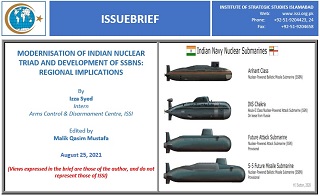India was the first state in the South Asian region to acquire nuclear weapons. In November 2018, as declared by the Indian Prime Minister Narendra Modi, India also became the first in the region to complete the nuclear triad which consists of land launched nuclear missiles, strategic aircraft capable of carrying nuclear missiles and submarines armed with nuclear missiles.[1] India’s three-sided nuclear force structure is based on “Prithvi short-range ballistic missiles and various versions of the Agni intermediate-range ballistic missile manned by the missile groups of the Indian Army; nuclear glide bombs carried on aircraft of the Indian Air Force (IAF) and, eventually, submarine-launched ballistic missiles (SLBMs) deployed on ballistic missile submarines (SSBNs) with the Indian Navy.”[2] The indigenous development of the nuclear powered ballistic missile submarine, INS Arihant, placed India in the league of the five great powers that can build and operate SSBNs.[3] This advancement put pressure on regional states as nuclear-armed submarines not only assure second-strike capability but unlike land and air-based nuclear weapon systems, are also impossible to detect.
Home ISSI Publications Articles Young ISSI Professionals Corner Issue Brief on “Modernisation of Indian Nuclear Triad and Development of SSBNs:...















